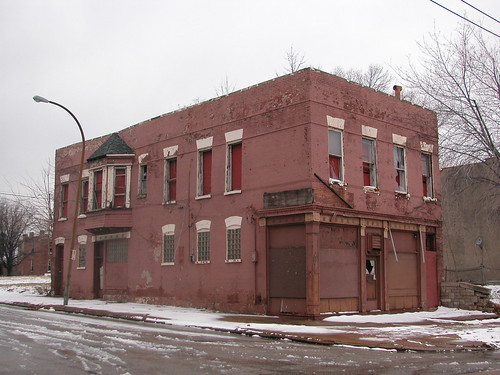by Michael R. Allen
 Days that came, years again
Days that came, years again
Came in here once again
— John Cale, “Big White Cloud”
One of the highlights of this gloomy week has been a look at one of the north side’s biggest development stories: the removal of the failed pedestrian mall on 14th Street in Old North. As part of the $35 million Crown Square project, the city has removed the street closures and is working on reconstructing both the two closed blocks of 14th Street between St. Louis Avenue and Warren Street and the two closed blocks of Montgomery Street between Blair Avenue and 13th Street. While work on the 27 historic buildings being rehabilitated has been underway since September 2007 and is nearing completion, delays forced the actual street work to this fall. The streets should be reopened in the spring.
Already the removal of the mall’s pavement, trees and light posts has opened views around the now-rehabilitated historic buildings. The sense of connection to the surrounding neighborhood slowly lost after the pedestrian mall opened in 1977 has returned. All that awaits are actual sidewalks, street lights and the centerpiece street.

People are already there. Headhunters Salon has remained open on the mall during construction, and Peter Sparks has been working on his building at the northwest corner of Montgomery and 14th. Sparks envisions a gallery and art studios. More recently, residents have moved into many of the units in the buildings on 14th Street. For now, they enter through rear entrances. In the future, the residents will be able to walk up and down 14th Street.
 One of the first storefront spaces to be occupied is the new office of the Old North St. Louis Restoration Group at 2700 N. 14th Street. Built in 1925, the one-story commercial building had been robbed of its shaped parapet and clad in enamel panels in 1955. Through design by Rosemann Associates and historic research by Matt Bivens of the Regional Housing and Community Development Alliance (RHCDA), the building has been returned to historic appearance. Inside is both the office of the Restoration group and a large community exhibit and meeting space, shown below.
One of the first storefront spaces to be occupied is the new office of the Old North St. Louis Restoration Group at 2700 N. 14th Street. Built in 1925, the one-story commercial building had been robbed of its shaped parapet and clad in enamel panels in 1955. Through design by Rosemann Associates and historic research by Matt Bivens of the Regional Housing and Community Development Alliance (RHCDA), the building has been returned to historic appearance. Inside is both the office of the Restoration group and a large community exhibit and meeting space, shown below.
 The office features sliding doors made of slavaged floor boards and a reception desk made of timbers that once were part of the floor system in the building.
The office features sliding doors made of slavaged floor boards and a reception desk made of timbers that once were part of the floor system in the building.
 The view from that desk shows the fruits of the organization’s hard work. The Restoration Group is a development partner with RHCDA in Crown Square. The community development corporation spent over a decade trying to spur redevelopment of the pedestrian mall area. Now that the redevelopment is almost done, the organization appropriately has moved into a new space in the heart of the project and at the center of the neighborhood. Once the street reopens, the office will be easy to find. Large windows provide a visual connection to neighborhood.
The view from that desk shows the fruits of the organization’s hard work. The Restoration Group is a development partner with RHCDA in Crown Square. The community development corporation spent over a decade trying to spur redevelopment of the pedestrian mall area. Now that the redevelopment is almost done, the organization appropriately has moved into a new space in the heart of the project and at the center of the neighborhood. Once the street reopens, the office will be easy to find. Large windows provide a visual connection to neighborhood.
Another north side development story this week involved the formal announcement of a redevelopment agreement for the Northside Regeneration project. That project’s developer, McEagle Properties, has a long way to go before it completes its first $35 million is actual redevelopment. Meanwhile, McEagle needs the support and good will of the north side residents and businesspeople its project aims to serve. Why not open a field office like the new Old North St. Louis Restoration Group office? McEagle’s physical presence has been limited to vacant buildings, orange construction fencing and hired lawn mowing crews. That’s quite a contrast to a pleasant office and community space with big storefront windows, a friendly staff and a welcome mat. Presence in the community doesn’t happen at press conferences, on Twitter or through fancy websites — it happens on the street, where eveyone can find it.











